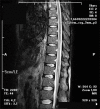Transient paraplegia after neurolytic splanchnic block in a patient with metastatic colon carcinoma
- PMID: 29372026
- PMCID: PMC5780216
- DOI: 10.3344/kjp.2018.31.1.50
Transient paraplegia after neurolytic splanchnic block in a patient with metastatic colon carcinoma
Abstract
We present a patient with metastatic colon carcinoma who developed paraplegia following a neurolytic splanchnic block. A 41-year old man with metastatic adenocarcinoma of the colon received a splanchnic neurolytic block using alcohol because of severe abdominal pain. Bilateral motor weakness and a sensorial deficit in both legs developed after the procedure. Diffusion magnetic resonance imaging revealed spinal cord ischemia between T8 and L1. The motor and sensorial deficits were almost completely resolved at the end of the third month. We think that anterior spinal artery syndrome due to reversible spasms of the lumbar radicular arteries using alcohol have resulted in transient paraplegia. The retrograde spread of alcohol to neural structures may have also contributed.
Keywords: Alcohol; Cancer; Complication; Pain; Paraplegia; Splanchnic block.
Figures
References
-
- Mercadante S, Catala E, Arcuri E, Casuccio A. Celiac plexus block for pancreatic cancer pain: factors influencing pain, symptoms and quality of life. J Pain Symptom Manage. 2003;26:1140–1147. - PubMed
-
- Süleyman Ozyalçin N, Talu GK, Camlica H, Erdine S. Efficacy of coeliac plexus and splanchnic nerve blockades in body and tail located pancreatic cancer pain. Eur J Pain. 2004;8:539–545. - PubMed
-
- Papadopoulos D, Kostopanagiotou G, Batistaki C. Bilateral thoracic splanchnic nerve radiofrequency thermocoagulation for the management of end-stage pancreatic abdominal cancer pain. Pain Physician. 2013;16:125–133. - PubMed
Publication types
LinkOut - more resources
Full Text Sources
Other Literature Sources



